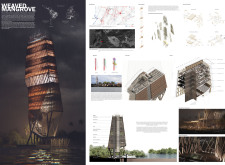5 key facts about this project
The design focuses on a tower located in the mangroves of Buenaventura, Colombia. Its main purpose is to restore the relationship between human habitation and the natural environment. The tower acts as a community space while addressing important issues such as illegal wood trafficking. By using principles from vernacular architecture, the design integrates with the unique features of the mangrove landscape.
Site Context
The tower is positioned on Cangrejo Island, which is 1.7 kilometers from the urban edge. This location allows for effective monitoring of timber traffic, highlighting the importance of environmental governance. The site's characteristics have greatly influenced the design and the various functions of the tower. The aim is to create a structure that complements the natural surroundings while serving the community's needs.
Structural Organization
The design incorporates stilt structures that elevate living spaces above the risk of flooding. This is a necessary response to the water dynamics found in mangrove ecosystems. The central tubular system provides a large void, with beams connecting the outer walls and supporting the structure. This organization enhances the tower's strength and facilitates better load distribution.
Cultural Integration
The façade of the tower draws from local Wounaan culture, specifically referencing traditional Werregue weaving techniques. This choice not only adds aesthetic value but also connects the architecture to the local community. A permeable membrane made from renewable vegetable materials is used to promote sustainability. It protects against moisture and sunlight while being easy to maintain.
Programmatic Elements
The tower includes spaces that encourage community engagement and education. It features workshops for carpentry and canoe repair, promoting local skills and traditions. Educational facilities focused on sustainable fishing practices further enhance community involvement. Additionally, spaces like a hostel and communal areas provide economic opportunities while educating visitors about the environment.
The intricate façade showcases woven patterns that represent local craftsmanship, establishing a connection between the tower and its natural surroundings. This blend of architecture and culture creates a distinct identity that resonates with the landscape.




















































